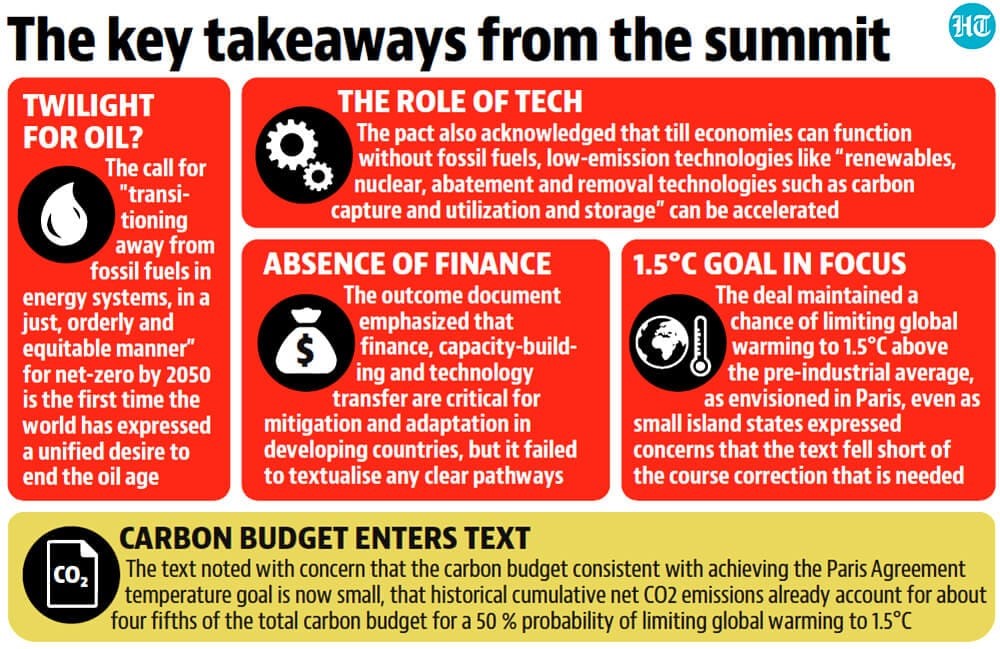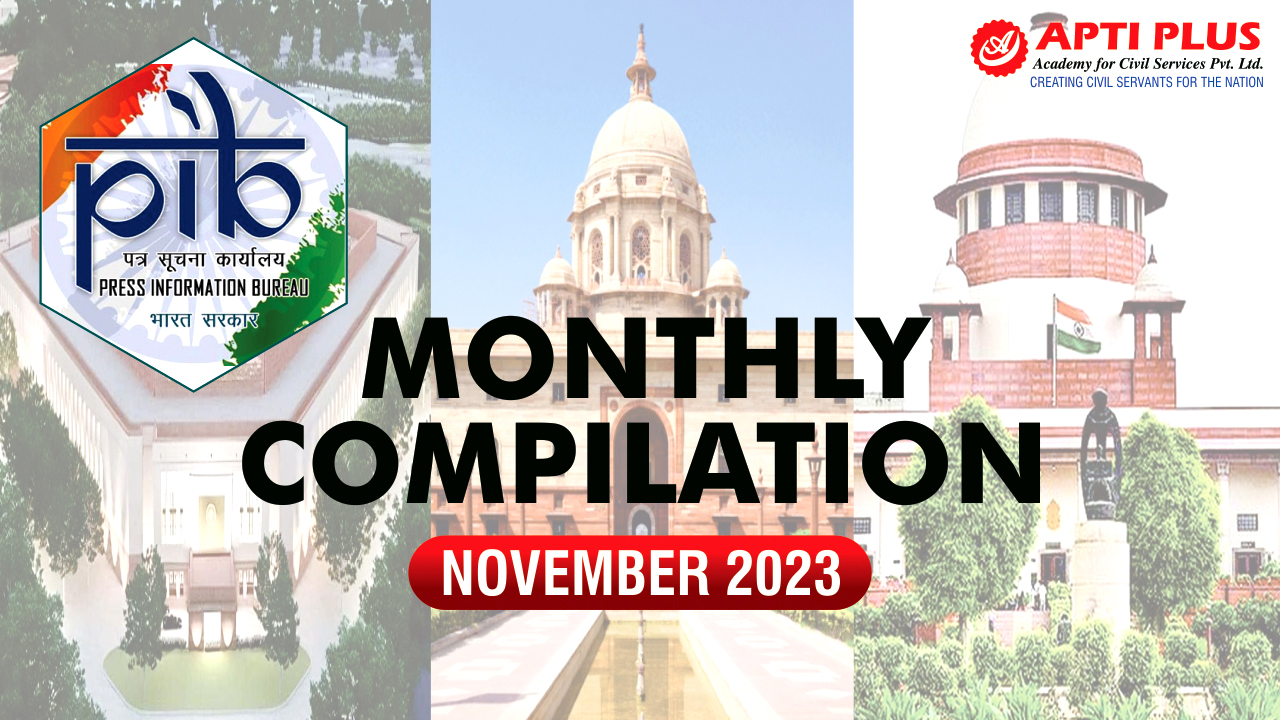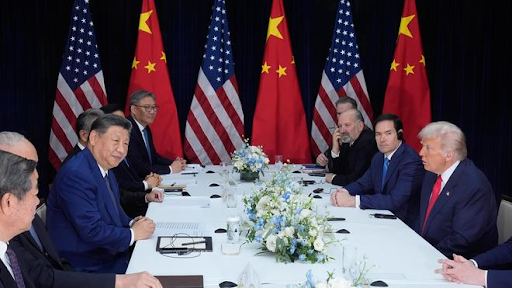Description

Disclaimer: Copyright infringement not intended.
Context
- The COP28 climate summit was concluded in Dubai with an agreement headlining on the need for a global journey away from fossil fuels.
What is a COP?
- The Conference of the Parties (COP) is the main decision-making body of the United Nations Framework Convention on Climate Change (UNFCCC). It brings together the 198 Parties –197 nations plus the European Union – that have signed on to the Framework Convention.
- The inaugural COP gathering took place in Berlin, Germany, in March 1995, and today the COP secretariat is headquartered in Bonn. COPs are hosted annually in different countries, under the auspices of the UNFCCC, with the UAE hosting COP28.
Why is COP important?
- COPs serve as the formal meeting place each year for the Parties to negotiate and agree on how to tackle climate change, reduce emissions and limit global warming. A primary task at COPs is the examination of national reports and emission inventories submitted by participating countries.
- These reports offer essential insights into each country's actions and their progress toward achieving the overarching goals of the Convention.
How does the COP Presidency rotate?
- The COP meets every year unless the Parties decide otherwise. The COP Presidency rotates among the five recognized UN regions - Africa, Asia, Latin America and the Caribbean, Central and Eastern Europe and Western Europe and others. This rotation ensures that different corners of the world have the opportunity to host and showcase their commitment to addressing climate challenges.
- The 2023 United Nations Climate Change Conference or Conference of the Parties of the UNFCCC, more commonly known as COP28, was the 28th United Nations Climate Change conference, held from 30 November to 13 December at Expo City, Dubai, United Arab Emirates.

Key Outcomes
- Now that the summit is over and the dust has settled, we examine the key outcomes.
The end of fossil fuels?
- Perhaps surprisingly, this was the first COP to officially acknowledge that fossil fuels are the root cause of climate change. And it is worth remembering that fossil fuels were only first mentioned in an international climate agreement in 2021 at COP 26 in Glasgow. Yet it still lacked ambition.
- Most countries wanted a strong statement on phasing out or at the very least phase down (reducing) fossil fuels. Instead countries agreed a statement saying we must “transition away from fossil fuels in energy systems, in a just, orderly and equitable manner, accelerating action in this critical decade, so as to achieve net zero by 2050 in keeping with the science”.
- This language—a “transition away” rather than a full “phase-out”—is not as strong as many wanted. As a statement made by Samoa on behalf of the Alliance of Small Island States put it, these decisions are “an incremental advancement over business as usual” when what is needed is “exponential step-change” to keep 1.5°C alive.
- In theory the agreement heralds the end of the fossil fuel era, but it offers an intentional loophole for countries and companies to “abate” the use of fossil fuels by using carbon capture and storage. This justifies the continued burning of oil and gas.
- Loss and damage
- “Loss and damage” is the term given for finance for developing countries that have suffered a major climate change-related disaster. A fund was agreed at COP 27 in 2022 and recent announcements mean US$700 million has now been pledged.
- While this is welcome news it is a drop in the ocean compared with the US$400 billion actually needed. It’s also insignificant compared to, for instance, the estimated US$7 billion cost of building the COP 28 venue Dubai Expo City.
- It is still not clear how the fund will work, what the major funding streams will be or whether the allocation of finance will be community-driven and corruption-free. And despite opposition, it has been agreed the World Bank will administer the fund for a negotiated fee of 24%—meaning one in four dollars pledged will never make it to the countries in need.
- So overall, this summit did not deliver on climate finance and this key issue has been pushed to COP 29 November 2024.
- Renewable energy and transitional fuels
- A pledge signed by 118 countries to triple renewable energy capacity and double the global rate of energy efficiency by 2030 is a step in the right direction.
- It is worth noting the text of the pledge also recognizes the role “transitional fuels” will have in maintaining energy security for the time being. This makes the use of climate-damaging liquefied petroleum gas acceptable. This isn’t ideal, but in developing countries, it is still a healthier and less polluting option for home cooking and heating than burning wood or other biomass. Nonetheless, there really should be a timeline attached to the use of these transitional fuels.
- On the sidelines of COP 28, green hydrogen also had its moment. Produced through a process that splits water using electricity generated from wind or solar power, industries pledged to scale up zero-emissions fuel derived from renewables-based hydrogen to 11 million tonnes by 2030.
- Oil and gas decarbonization charter
- Over 50 national and international oil companies, representing about 40% of global production, signed a decarbonization charter. The initiative sets three main aims: to achieve net zero emissions in each company’s direct operations (as opposed to the use of their products) by or before 2050, to achieve near-zero methane leakage from the production of oil and gas by 2030, and to achieve zero routine flaring (burning excess gas) by 2030.
- The last two pledges are particularly important as methane is a very powerful (but short-lived) greenhouse gas and a quarter of all man-made methane emissions come from oil and gas production.
- So, reducing these emissions is a quick win which buys us time. But again, 60% of world oil and gas production is not covered by this charter. These companies will continue to save money by venting methane and flaring natural gas.
- Global stocktake—1.5°C is at risk
- The “global stocktake”, finalized at COP 28, was the first time the global climate regime took stock of how the international community has collectively reduced its greenhouse gas emissions since the Paris Agreement in 2015.
- The biggest takeaway from the stocktake told us what we already knew—the world is way behind and the 1.5°C warming limit agreed in Paris is at risk.
- While the big takeaway from COP 28 will be that countries have come up with a deal that calls for them to transition away from fossil fuels while acknowledging the need for a “deep, rapid” reduction in emissions, the weak language is at complete odds with the official global stocktake.

In a nutshell,
Loss And Damage
- COP28 saw a landmark agreement to support vulnerable nations facing the worst of climate change’s impacts.
- These can include: “the development of national response plans; addressing insufficient climate information and data, and promoting equitable, safe and dignified human mobility in the form of displacement, relocation, and migration, in cases of temporary and permanent loss and damage.”
- A geographically diverse board will be established, and the fund will be initially managed by the World Bank. The first pledges from wealthy nations were made in Dubai to support the fund and currently total over $650 million.
Climate Finance Target
- Progress was finally made on the new collective quantified goal (NCQG), which builds on the $100 billion pledged by developed nations to finance climate mitigation and adaptation initiatives in developing nations.
- Notably, that $100 billion goal has not yet been met (although it appears on track this year) and is far short of what is needed. COP saw an agreement to draft a post-2025 finance target ahead of COP29.
- This is a step forward, but like loss and damage last year, the details will only be hammered out next year.
Global Goal on Adaptation
- Continuing a theme from COP27, this COP saw emphasis put on supporting strategies for adapting to the impacts of climate change.
- The final text retains calls for a doubling in adaptation finance and plans for assessments and monitoring of adaptation needs in the coming years.
- Positively, an explicit 2030 date has been integrated into the text for targets on water security, ecosystem restoration, health. However, language was weakened around a commitment to closing the adaptation finance gap.
- Much of the financing language was pushed from the adaptation section into the implementation section of the COP text. Additional details on financing expectations and targets are needed at COP29.

Global Stocktake and Fossil Fuels
- The Global Stocktake was most scrutinized text at COP28. After fierce pushback on the watered-down language on emissions and fossil fuels, the final text saw a few improvements.
- It mentions the projection of peak global emissions between 2020-2025. Alignment around emissions reductions consistent with the goals of limiting warming to 1.5 degrees Celsius above preindustrial levels and reaching net zero by 2050 now made explicit.
- The final text more strongly “called on” nations to take a variety of actions to reduce emissions. It also stated the intention of “accelerating and substantially reducing non-CO2 emissions globally, including in particular methane emissions by 2030.”
- Unfortunately, some concerning language also made it into the final draft. That included weakening the coal statement from "rapidly phasing down unabated coal" and putting "limitations on permitting" to just speaking about "efforts towards the phase-down of unabated coal power."
- A paragraph now also mentions the role of "transitional fuels" read: gas (and perhaps oil) in the energy transition. On the central fossil fuel language, a “transition away” is called for rather than a “phaseout.” Notably, it only directly refers to fossil fuel use in in energy systems.
Carbon Markets
- Another closely watched area in Dubai was on carbon markets. Carbon markets are systems where countries or entities can buy and sell carbon credits, representing a reduction of greenhouse gases, to meet their climate targets.
- These markets can encourage cost-effective emissions reductions by providing financial incentives for emission-reducing projects. However, these markets have also been plagued by credibility concerns.
- Negotiators were trying to further define how credit markets would be supervised and how different types of credits would be accounted for.
- No agreement was reached and so key questions related to the permanence of the reductions/removals claimed will need to be addressed at COP29.
- This is an unfortunate outcome for those seeking to build vibrant and high-integrity carbon markets.
Other Key Themes (Just Transition and Nature)
- The final COP text included some important call-outs of the importance of delivering a just transition. The just transition was an important focus in the Global Stocktake, Global Goal on Adaptation, climate finance, and implementation agreements.
- However, more work will be required on what the just transition means in quantitative terms from emissions trajectories to climate finance obligations.
- Nature was also mentioned directly in the Global Goal on Adaptation, which spoke of “accelerating the use of ecosystem-based adaptation and nature-based solutions,” and there is growing recognition that climate goals demand nature-positivity. A promising 2030 deforestation goal was also part of the final text.
Overall
- The UAE hosts effectively managed the logistics of the largest COP in history.
- The conference reached landmark agreements on loss and damage and a clear ambition to transition away from fossil fuels.
- However, in the final accounting, much of the agreement feels like incrementalism.
- Against the urgency of the moment, during the hottest year on record, when giant leaps are needed, small steps are not enough.
Turning COP28 Commitments into Action
- For the first time, all nations formally agreed to move away from fossil fuels and rapidly ramp up renewable energy, while our cities and food systems were elevated in the climate fight like never before.
- Now that negotiators have left Dubai; attention turns to the next essential tasks: turning the goals expressed at COP28 into national action and ensuring the finance is there to implement them.
- Importantly, these commitments must be seen as the floor — not the ceiling — in the fight against climate change. Climate-vulnerable communities and countries cannot afford to be shortchanged.
- It is up to countries to translate the UAE Consensus into their next round of NDCs and transformative domestic legislation and policies, including ramping up renewables and fossil-free transport and tamping down fossil fuels at every turn.
- Global agreements can send the right signals, but the world’s fate will ultimately be determined by whether countries play their part in addressing the climate crisis.
Cop29 Host
- Baku in Azerbaijan will host COP29, avoiding an extension of the UAE presidency and a conference location in Bonn, Germany.
- This agreement was reached after Armenia and Russia dropped their of objections.
|
PRACTICE QUESTION
Q. COP 28 reached landmark agreements on loss and damage and a clear ambition to transition away from fossil fuels. Elucidate.
|










